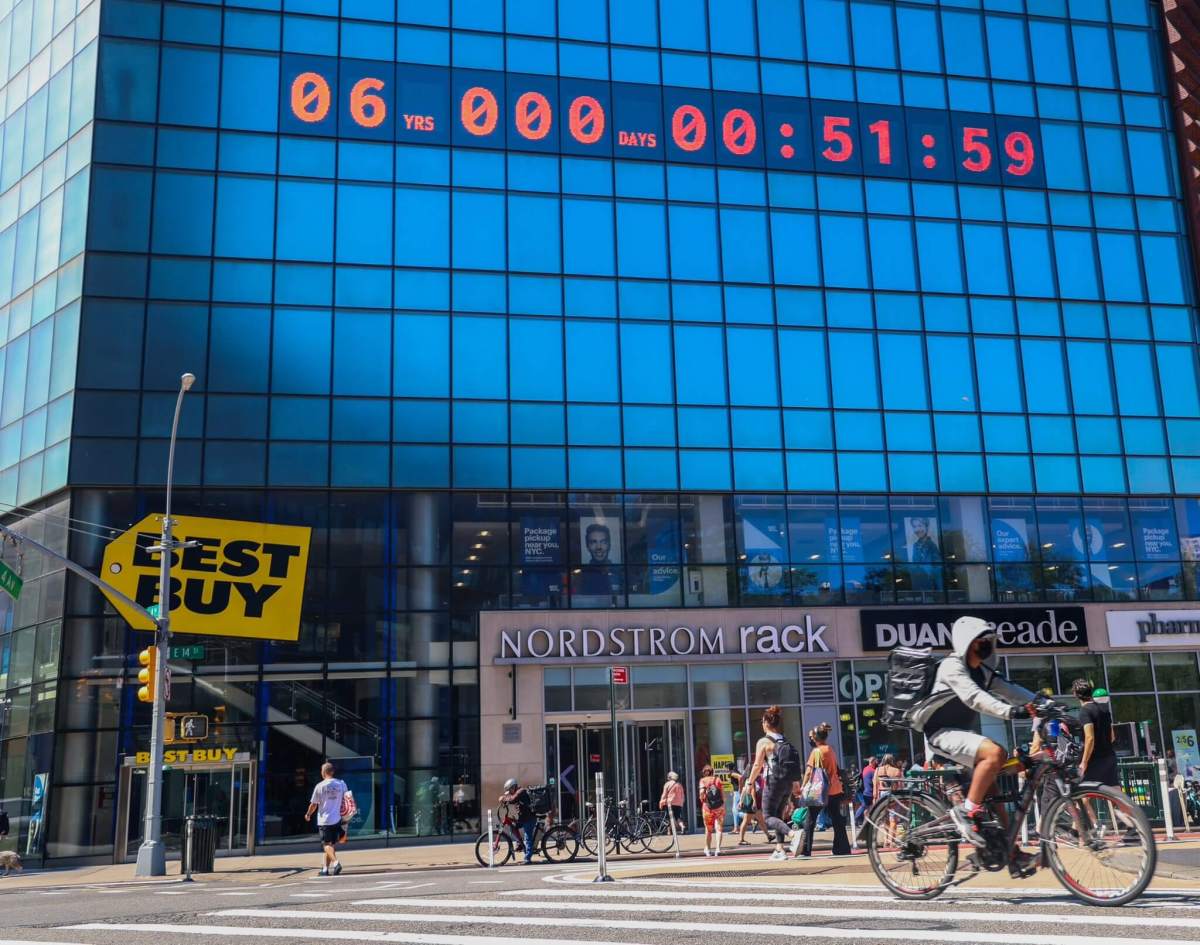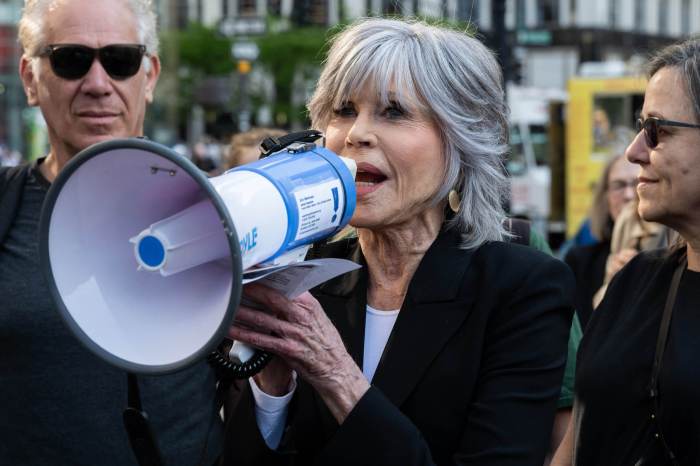Though you might not hear it, you’ve almost certainly seen it: the giant Climate Clock above Union Square’s department stores that hangs over our heads as a constant, daily reminder of the impacts of an ever-changing global climate.
The tick-tock of this clock logs the numbered days we have left to reverse the impacts of climate change and global warming. This past Saturday, the 80-foot, four-storied clock rung in the new climate year, though it wasn’t a celebration.
July 22 was a day to mark another year where governments, corporations, and communities can work together to reduce fossil fuel emissions around the world, the Climate Clock co-founders said.
Artists Andrew Boyd and Gan Golan are the ones behind Climate Clock, which combines art, technology, science, and activism to simultaneously count down the time left to dramatically reduce the global greenhouse gas emissions needed for a safe, livable climate, and pairs it with a solutions tracker noting prominent solutions and progress towards that goal.
New York City is one of several cities, including Rome, Prague, and Seoul, with a “monumental clock” placed in the center of its city slowly counting down the seconds, minutes, and hours till the planet’s average temperature climbs above 1.5 degrees Celsius, which scientists say will mark the point of no return when it comes to dramatic changes in the Earth’s climate.
Climate Clock launched in New York City in 2020 at Manhattan’s Union Square, surrounded by big-name-box stores and the pedestrian plaza where blitz chess players congregate and passersby catch a break. The climate clock in Union Square currently cycles through new messages every 15 minutes: “No more oil!”; “No greenwashing”; “Less net, more zero.”
The clock also displays the hotline for people experiencing anxiety around climate change, and statistics revealing the large number of youth experiencing climate anxiety.
Boyd, an artist who grew up in Manhattan and Brooklyn, has long produced work with activism, philosophy, and humor at its core. The same approach was channeled into his work around the climate and environment — a field notoriously difficult to communicate about without sounding a doomsday alarm — and creating messages to inspire conversations.
“We’re on a very ferocious timeline,” Boyd told amNewYork Metro. “The clock is telling us that at current emission rates, we have now less than six years before we lock in 1.5 degrees centigrade of warming.”
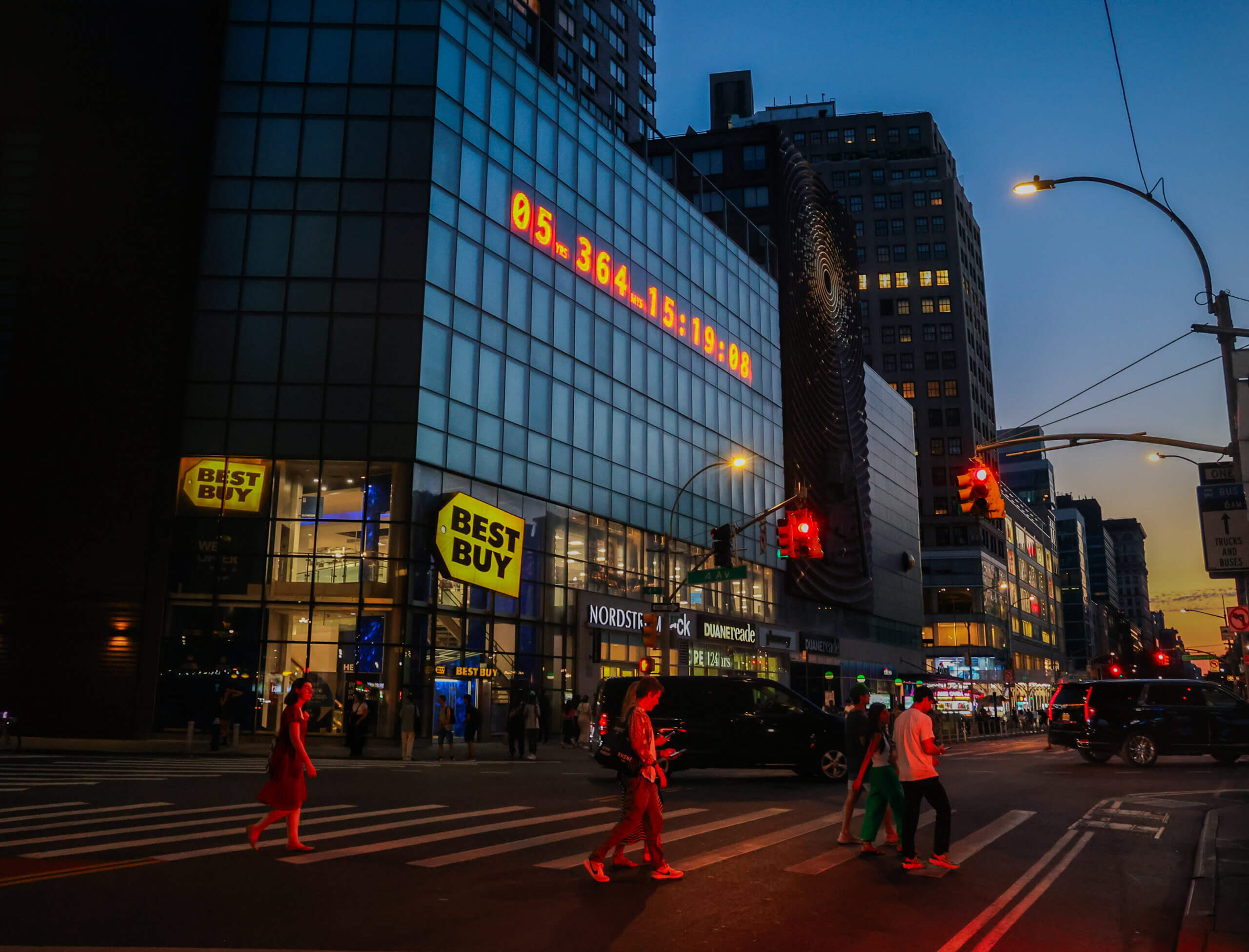
The impact already beginning
The climate crisis struck a chord with Golan in 2018 when his first child was born. His daughter’s birth was certainly profound, he said, but there was also a sense of grief lingering in the background. That same month, the United Nation’s Intergovernmental Panel on Climate Change (IPCC) had published a special report on global warming.
The report’s key message was that people across the world are already seeing the impacts of one degree Celsius of global warming: extreme weather, rising sea levels, diminishing Arctic sea ice, among other changes.
“I was so filled with joy, but so much grief for the future that we had created for my child and for all children,” Golan said.
The IPCC report’s authors highlighted that these impacts could be avoided by “limiting global warming to 1.5 degrees Celsius.” The 1.5 degrees has been associated with “long-lasting or irreversible changes, such as the loss of some ecosystems,” said Hans-Otto Pörtner, co-chair of IPCC Working Group II.
Becca Richie, a young, native New Yorker who works as the global community manager with Climate Clock, told amNewYork Metro there are many ways that New Yorkers can plug themselves into climate work.
“Since I’ve joined the organization, thousands of people have emailed us,” Richie said. “They see the potential for (the clock) to spark action and put the demands of a climate movement into the hands of the mass public.”
Boyd said the climate clock is a is a way for people to stay accountable to the evolving reality of the Earth’s climate and environment, and most importantly, “a way for us to hold our leaders accountable,” he added.
“If you’re someone who might be rallying for climate action, then the clock is a really great tool,” Richie said. “It tells us that we have that much less time to mess around.”
The past two weeks have been about helping the Climate Clock network around the world communicate their messages with greater clarity and impact, Golan told amNewYork Metro. The network is now as diverse as can be, and connected with people in around 30 countries.
“Our job is to serve climate activists and advocates who are already running campaigns in their countries,” Golan said. “We’re in full-time support mode.”
Ringing in the new “climate year” on Saturday was a big moment for Boyd to join and witness the existential urgency around climate change. The organizers played David Bowie’s “Five Years” to mark the new timeline, and drew messages on their hands to double down on their commitment to work on solutions for the next five years.
“We have a world historic level of responsibility to preserve a livable world by making a rapid, dramatic transition off of fossil fuels to renewable energy,” Boyd said. “This is a critical decade. Much of that we have to get to this decade.”
“There was a moment of silence and reflection,” Golan added. “People really came to terms with five years left in avoiding the worst impacts.”
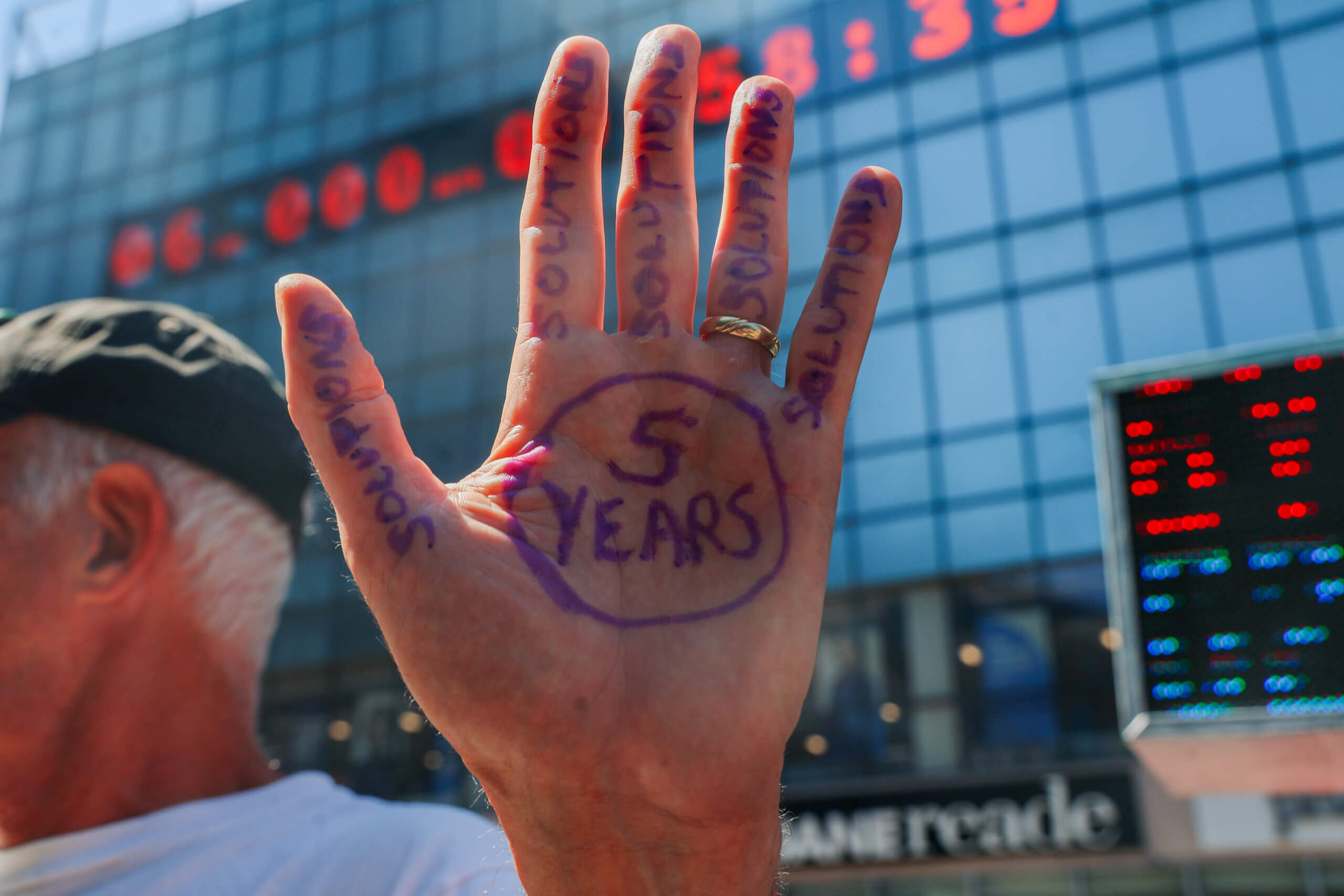
These impacts have been felt recently with record-breaking heat waves, wildfires, and floods. A new study published on July 25 by Peter and Susanne Ditlevsen from the University of Copenhagen warned that the Earth’s system of ocean currents, the Atlantic meridional overturning circulation, could be at a tipping point within this century.
If the system collapses, the researchers pointed out, this would have severe impacts on the climate in the North Atlantic region, which includes New York State.
“It’s like getting bad news from your doctor that you don’t want to hear,” Golan said. “But you have to hear it so you can fix the problem.”
While the timer can give off an ominous and threatening air, Boyd said that the intention is meant to inspire action, not fear. Boyd said that the idea is to shift your perspective when looking at or passing by the climate clock.
“We don’t look at that as a doomsday thing,” Boyd said. “When you look at it with an attitude of, “What do we need to do?,” then it becomes something very different,” Boyd said. “It becomes a beacon of hope. It becomes a call to action.”
There are many solutions that Boyd said can contribute to a more sustainable and greener world, whether locally in New York City or globally. He pointed to divestments from the fossil fuel industry, tracking financing owed by the wealthier countries in the Global North, Local Law 97, building more renewable energy infrastructure and creating green jobs, and restoring ecosystems.
“The clock is tracking our progress on key solution pathways,” Boyd said. “It’s a huge responsibility, but you can also think of it as a huge opportunity to make a difference.”
Golan said that the responsibility lies in both individuals to push leaders and governments, and in elected bodies to take global warming seriously and pursue solutions in their cities and countries.
“Having the climate clock is about setting a clear mission for action of what we need to do in the next five years,” Golan said. “We have a lot to accomplish in these years.”
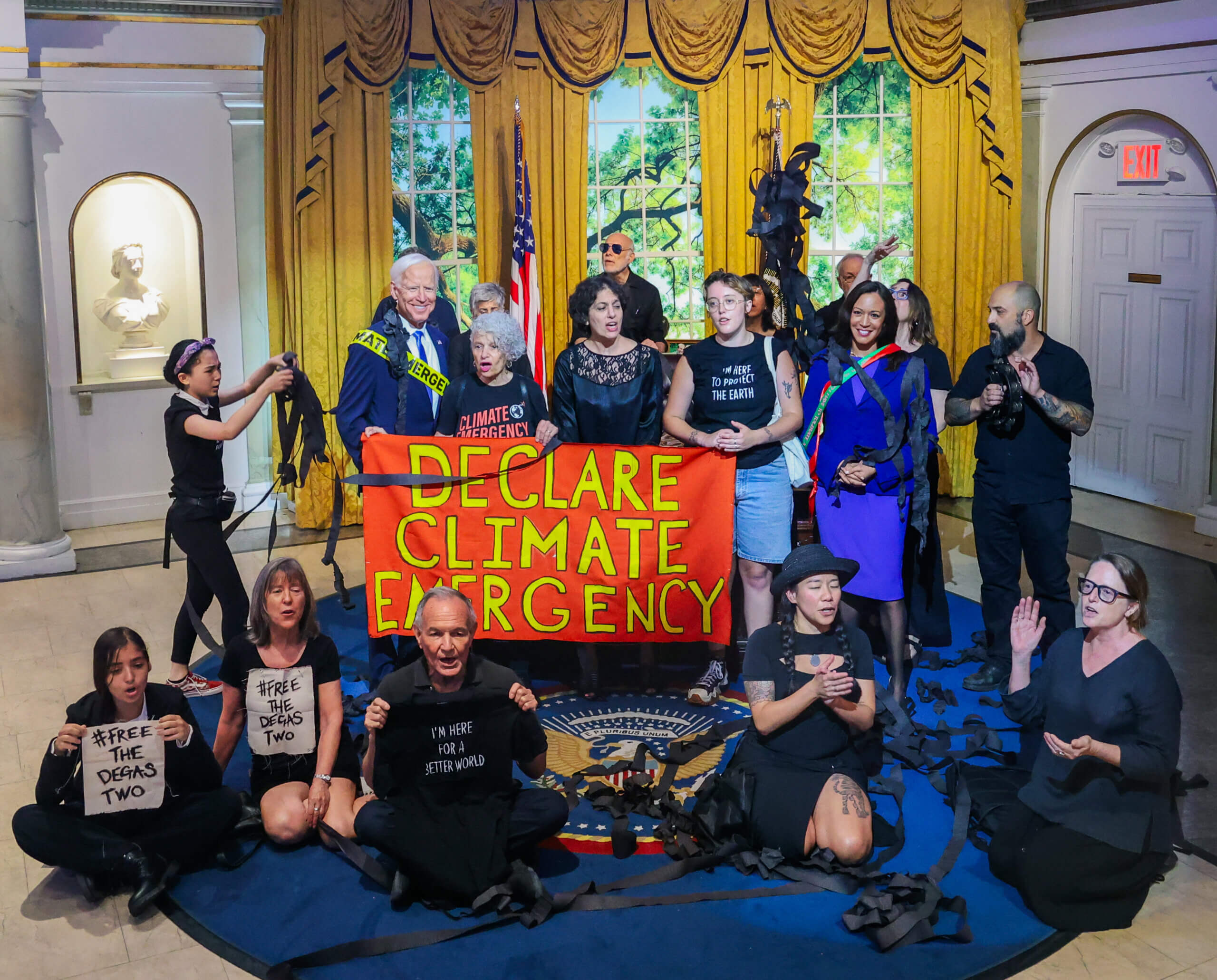
Read more: Can Landlords Enforce Building-Wide Smoking Bans?



